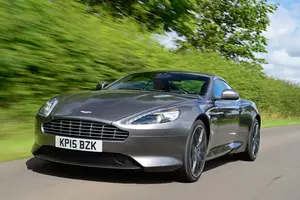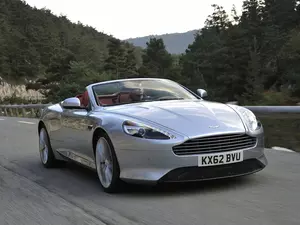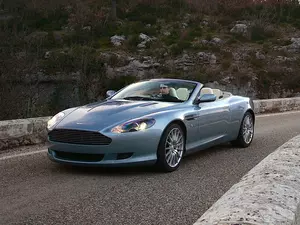
| Vehicle | Precise engine size | Difference from world average | Engine size to consumption ratio | Horsepower from 1 L | Engine size to 100 kg of weight |
|---|---|---|---|---|---|
| 6.0 V12 |
5.94 L (5935 cc) |
153% bigger | - | 92 hp from 1 L | 312 cc to 100 kg |
| Vehicle | 6.0 V12 |
|---|---|
| Precise engine size | 5.94 L (5935 cc) |
| Difference from world average | 153 bigger |
| Engine size to consumption ratio | - |
| Horsepower from 1 L | 92 hp from 1 L |
| Engine size to 100 kg of weight | 312 cc to 100 kg |

| Vehicle | Precise engine size | Difference from world average | Engine size to consumption ratio | Horsepower from 1 L | Engine size to 100 kg of weight |
|---|---|---|---|---|---|
| 6.0 V12 |
5.94 L (5935 cc) |
153% bigger | - | 92 hp from 1 L | 330 cc to 100 kg |
| Vehicle | 6.0 V12 |
|---|---|
| Precise engine size | 5.94 L (5935 cc) |
| Difference from world average | 153 bigger |
| Engine size to consumption ratio | - |
| Horsepower from 1 L | 92 hp from 1 L |
| Engine size to 100 kg of weight | 330 cc to 100 kg |

| Vehicle | Precise engine size | Difference from world average | Engine size to consumption ratio | Horsepower from 1 L | Engine size to 100 kg of weight |
|---|---|---|---|---|---|
| 6.0 V12 |
5.94 L (5935 cc) |
153% bigger | 371 cc to 1 mpg | 87 hp from 1 L | 330 cc to 100 kg |
| Vehicle | 6.0 V12 |
|---|---|
| Precise engine size | 5.94 L (5935 cc) |
| Difference from world average | 153 bigger |
| Engine size to consumption ratio | 371 cc to 1 mpg |
| Horsepower from 1 L | 87 hp from 1 L |
| Engine size to 100 kg of weight | 330 cc to 100 kg |

| Vehicle | Precise engine size | Difference from world average | Engine size to consumption ratio | Horsepower from 1 L | Engine size to 100 kg of weight |
|---|---|---|---|---|---|
| 6.0 V12 |
5.94 L (5935 cc) |
153% bigger | 371 cc to 1 mpg | 87 hp from 1 L | 312 cc to 100 kg |
| Vehicle | 6.0 V12 |
|---|---|
| Precise engine size | 5.94 L (5935 cc) |
| Difference from world average | 153 bigger |
| Engine size to consumption ratio | 371 cc to 1 mpg |
| Horsepower from 1 L | 87 hp from 1 L |
| Engine size to 100 kg of weight | 312 cc to 100 kg |

| Vehicle | Precise engine size | Difference from world average | Engine size to consumption ratio | Horsepower from 1 L | Engine size to 100 kg of weight |
|---|---|---|---|---|---|
| 6.0 i V12 48V |
5.94 L (5935 cc) |
153% bigger | - | 77 hp from 1 L | 330 cc to 100 kg |
| R 6.0 V12 |
5.94 L (5935 cc) |
153% bigger | - | 102 hp from 1 L | 540 cc to 100 kg |
| RS 6.0 V12 |
5.94 L (5935 cc) |
153% bigger | - | 94 hp from 1 L | 540 cc to 100 kg |
| Vehicle | 6.0 i V12 48V |
|---|---|
| Precise engine size | 5.94 L (5935 cc) |
| Difference from world average | 153 bigger |
| Engine size to consumption ratio | - |
| Horsepower from 1 L | 77 hp from 1 L |
| Engine size to 100 kg of weight | 330 cc to 100 kg |
| Vehicle | R 6.0 V12 |
| Precise engine size | 5.94 L (5935 cc) |
| Difference from world average | 153 bigger |
| Engine size to consumption ratio | - |
| Horsepower from 1 L | 102 hp from 1 L |
| Engine size to 100 kg of weight | 540 cc to 100 kg |
| Vehicle | RS 6.0 V12 |
| Precise engine size | 5.94 L (5935 cc) |
| Difference from world average | 153 bigger |
| Engine size to consumption ratio | - |
| Horsepower from 1 L | 94 hp from 1 L |
| Engine size to 100 kg of weight | 540 cc to 100 kg |

| Vehicle | Precise engine size | Difference from world average | Engine size to consumption ratio | Horsepower from 1 L | Engine size to 100 kg of weight |
|---|---|---|---|---|---|
| 6.0 i V12 |
5.94 L (5935 cc) |
153% bigger | - | 77 hp from 1 L | 349 cc to 100 kg |
| 6.0 i V12 48V |
5.94 L (5935 cc) |
153% bigger | - | 77 hp from 1 L | 330 cc to 100 kg |
| Vehicle | 6.0 i V12 |
|---|---|
| Precise engine size | 5.94 L (5935 cc) |
| Difference from world average | 153 bigger |
| Engine size to consumption ratio | - |
| Horsepower from 1 L | 77 hp from 1 L |
| Engine size to 100 kg of weight | 349 cc to 100 kg |
| Vehicle | 6.0 i V12 48V |
| Precise engine size | 5.94 L (5935 cc) |
| Difference from world average | 153 bigger |
| Engine size to consumption ratio | - |
| Horsepower from 1 L | 77 hp from 1 L |
| Engine size to 100 kg of weight | 330 cc to 100 kg |